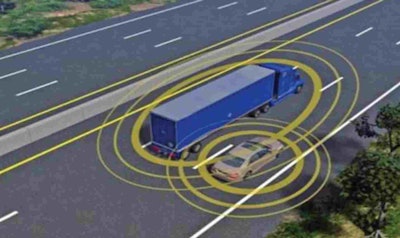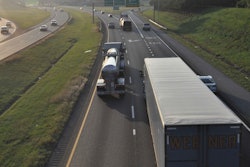
Now that mobile fleet management platforms are able to connect with a wider variety of devices, sensors and apps inside and outside of vehicles, the possibilities to make drivers and trucks more efficient and safe have expanded.
Some are describing the rapidly growing ecosystem of trucking technology as an “Interstate of Things” or an “Internet of Transportation Things.”
Software developers are now able to create new apps that connect trucks and drivers to real-time services to bypass inspection stations, to pay for toll roads, to reserve parking spots and other functions without having to invest in any hardware or infrastructure.
A growing number of these vehicle-to-infrastructure (V2I) and vehicle-to-vehicle (V2V) applications use cellular networks, or the Commercial Mobile Radio Service (CMRS), and smart devices that are widely deployed in the industry.
Transponder-based systems also continue to be widely used for weigh station bypass and toll road applications that require a high degree of speed and accuracy to verify trucks moving at highway speeds.
V2V applications have the potential to prevent accidents and improve efficiency by instantly sharing information using high-speed 5.9 GHz radio or Dedicated Short Range Communication (DSRC).
Bypassing with CMRS
When Brian Heath founded DriveWyze in 2010, the company did not invest in any hardware or infrastructure to offer a mobile weigh station bypass service. The telematics devices in trucks and the smartphones in driver’s pockets already provided the necessary GPS, cellular connections and computing power.
 The DriveWyze PreClear app works on in-cab devices and smartphones to notify drivers when they can bypass inspection stations.
The DriveWyze PreClear app works on in-cab devices and smartphones to notify drivers when they can bypass inspection stations.The CMRS app from DriveWyze is part of a cloud-based bypass program called PreClear that currently 35 states use at 616 sites (264 mobile and 352 fixed). The states that use the program can set their inspection criteria based on the Inspection Selection System from the Federal Motor Carrier Safety Administration and other data sources.
The Drivewyze app gives drivers of qualified carriers a bypass notification on their in-cab display as trucks approach an inspection site at highway speeds. The notification is triggered when the Drivewyze app crosses a virtual boundary, or geofence, set up in advance — usually a couple of miles — from the inspection point.
Law enforcement officers are connected to the online PreClear system to identify the vehicles that are cleared for bypass. The service costs fleets approximately $15 per truck per month.
Heath says the PreClear bypass system is integrated with weigh-in-motion systems as well.
As a future initiative, Heath, who is president of Drivewyze, says the company is working to create a voluntary bypass program for Level 3 inspections. This year, Drivewyze will be testing this program in four states in partnership with telematics companies that provide electronic driver logging applications.
The new program is being designed to help carriers and drivers get back on the road more quickly following a roadside inspection, he says. The data entry portion of the inspection process, including receipt of electronic log data, will be automated so that the enforcement officer can get through the inspection faster, he adds.
Going with RFID
For years, toll booths and weigh-in-motion (WIM) systems have been using 915 MHz transponders to instantly and accurately identify vehicles as they pass through readers in dedicated traffic lanes. Will these RFID systems be making a transition to CMRS or DSRC anytime soon?
HELP Inc., the provider of PrePass weigh station bypass services, has tested its own CMRS technology, but the latency of cellular networks and cloud-based apps “make it almost impossible to link effectively with weigh-in-motion systems,” says Karen Rasmussen, president and chief executive officer.
 Last fall, HELP Inc. announced the availability of the ElitePass transponder that allows weigh station bypass and electronic toll payment.
Last fall, HELP Inc. announced the availability of the ElitePass transponder that allows weigh station bypass and electronic toll payment.HELP, Inc., plans to build 13 new WIM sites this year in partnership with state agencies. Going forward, all of its new Prepass sites will be equipped with WIM to screen trucks for safety credentials and weight.
Rasmussen believes that CMRS “will eventually get there” and be a viable option for WIM, “but until we can assure it can provide the same level of accuracy and speed that RFID does, we won’t deploy it.”
One advantage of keeping the RFID transponders in place is the ability to use a single transponder to bypass weigh stations and pay for tolls coast to coast. Last fall, PrePass announced its new ElitePass transponder that does just that, she says.
Rasmussen said that PrePass may eventually decide to use a DSRC transponder as government and industry deploy the infrastructure and systems on vehicles to create demand, such as using DSRC to communicate available parking spots to a truck moving on the highway.
At present, DSRC is more of a roadmap for future vehicle safety systems that will give drivers immediate alerts when a vehicle enters an intersection or approaches a dangerous curve, for example. Most of the IoT activity that is happening today in transportation is with CMRS since the foundation — the connected vehicle — is already in place.













